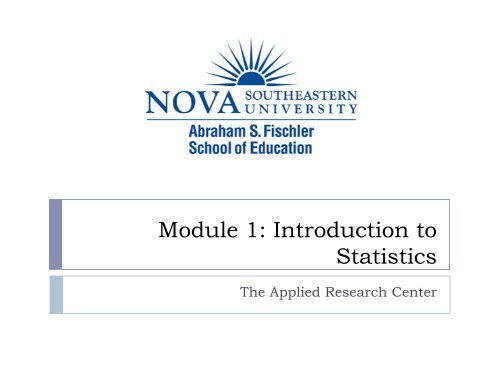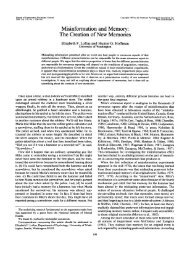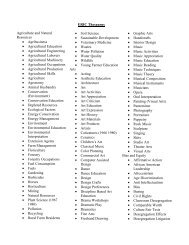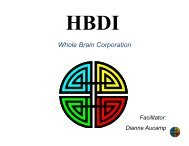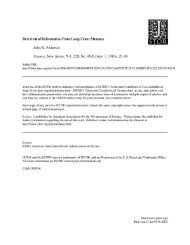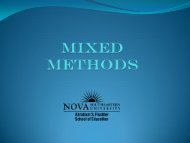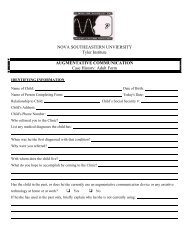Module 1 Introduction to Statistics.pdf
Module 1 Introduction to Statistics.pdf
Module 1 Introduction to Statistics.pdf
You also want an ePaper? Increase the reach of your titles
YUMPU automatically turns print PDFs into web optimized ePapers that Google loves.
<strong>Module</strong> 1: <strong>Introduction</strong> <strong>to</strong><br />
<strong>Statistics</strong><br />
The Applied Research Center
<strong>Module</strong> 1 Overview<br />
} The Role of <strong>Statistics</strong><br />
} The Research Process<br />
} Threats <strong>to</strong> Validity<br />
} Statistical Terminology<br />
} Scales of Measurement<br />
} <strong>Introduction</strong> <strong>to</strong> Descriptive and Inferential <strong>Statistics</strong>
The Role of <strong>Statistics</strong><br />
} The goal of virtually all quantitative research studies is <strong>to</strong><br />
identify and describe relationships among constructs.<br />
} Data are collected in a very systematic manner and<br />
conclusions are drawn based on the data.<br />
} At a basic level, statistical techniques allow us <strong>to</strong><br />
aggregate and summarize data in order for researchers <strong>to</strong><br />
draw conclusions from their study.
The Typical Research Process<br />
} The typical quantitative study involves a series of steps,<br />
one of which is statistical analysis.<br />
} Note: These are steps in the research process and NOT<br />
sections of the dissertation.<br />
The Research Process<br />
Step 1:<br />
Research<br />
Questions &<br />
Hypotheses<br />
Step 2:<br />
Operationalize<br />
& Choose<br />
Measures<br />
Step 3:<br />
Choose a<br />
Research<br />
Design<br />
Step 4:<br />
Analyze<br />
Data<br />
Step 5:<br />
Draw<br />
Conclusions
Step 1: Research Questions<br />
} Research questions reflect the problem that the<br />
researcher wants <strong>to</strong> investigate.<br />
} Research questions can be formulated based on theories,<br />
past research, previous experience, or the practical need<br />
<strong>to</strong> make data-driven decisions in a work environment.<br />
} Research questions are vitally important because they, in<br />
large part, dictate what type of statistical analysis is<br />
needed as well as what type of research design may be<br />
employed.
Examples of Research Questions<br />
} How is financial need related <strong>to</strong> retention after the<br />
freshman year of college?<br />
} What types of advertising campaigns produce the highest<br />
rates of inquiries among prospective applicants at NSU?<br />
} How do males and females differ with respect <strong>to</strong> statistics<br />
self-efficacy?<br />
} How does a body image curriculum improve body image<br />
in college females?
Hypotheses<br />
} While research questions are fairly general, hypotheses<br />
are specific predictions about the results, made prior <strong>to</strong><br />
data collection.<br />
} As financial need increases, the likelihood of retention<br />
decreases.<br />
} Personalized letters result in more inquiries than brochures.<br />
} Males have higher levels of self-efficacy than females.<br />
} Body image will improve as a result of the new curriculum.
Step 2: Operationalize & Choose<br />
Measures<br />
} Many variables of interest in education and psychology<br />
are abstract concepts that cannot be directly measured.<br />
} This doesnt preclude us from studying these things, but<br />
requires that we clearly define the specific behaviors that<br />
are related <strong>to</strong> the concept of interest.
Measuring Abstract Concepts<br />
} How does one measure retention, inquiry rate, statistics<br />
self-efficacy, and body image?<br />
} The process of defining variables and choosing a reliable<br />
and accurate measurement <strong>to</strong>ol is called operationalizing<br />
your variables.<br />
} Good measurement is vital <strong>to</strong> the trustworthiness of<br />
your results!
Step 3: Choose a Research Design<br />
} In Step 3, we develop a plan for collecting the data we<br />
need (i.e., a blueprint for the study)<br />
} This is called research design, and includes things such<br />
as:<br />
} Who will participate in the study?<br />
} Who will receive the intervention?<br />
} Will there be a control group?<br />
} Will data be collected longitudinally?<br />
} What instrument will be used <strong>to</strong> collect data?<br />
} What type of data will be collected?
Threats <strong>to</strong> Validity<br />
} Internal Validity<br />
} Problems associated with the experimental procedures or<br />
experiences of participants<br />
} External Validity<br />
} Problems that affect the generalizability of the results<br />
} The choice of design impacts the validity of your final<br />
results
Step 4: Analyze The Data<br />
} Once the data have been collected, the results must be<br />
organized and summarized so that we can answer the<br />
research questions.<br />
} This is the purpose of statistics<br />
} The choice of analysis at this stage depends entirely on<br />
two prior steps:<br />
} The research questions<br />
} How the variable is measured
Step 5: Draw Conclusions<br />
} After analyzing the data, we can make judgments about<br />
our initial research questions and hypotheses.<br />
} Are these results consistent with previous studies?<br />
} The conclusions drawn from a study may provide a<br />
starting point for new research.
The Role of <strong>Statistics</strong><br />
} Despite the anxiety usually associated with statistics, data<br />
analysis is a relatively small piece of the larger research<br />
process.<br />
} There is a misconception that the trustworthiness of<br />
statistics is independent of the research process itself.<br />
} This is absolutely incorrect!<br />
} A statistical analysis can in no way compensate for a<br />
poorly designed study!!!!
Statistical Terminology
Population<br />
} A population is the entire set of individuals that we are<br />
interested in studying.<br />
} This is the group that we want <strong>to</strong> generalize our results<br />
<strong>to</strong>.<br />
} Although populations can vary in size, they are usually<br />
quite large.<br />
} Thus, it is usually not feasible <strong>to</strong> collect data from the<br />
entire population.
Sample<br />
} A sample is a subset of individuals selected from the<br />
population.<br />
} In the best case, the sample will be representative of the<br />
population.<br />
} That is, the characteristics of the individuals in the sample<br />
will mirror those in the population.
Parameters vs. <strong>Statistics</strong><br />
} In most studies, we wish <strong>to</strong> quantify some characteristic<br />
of the population.<br />
} Example:<br />
} The retention rate, inquiry rate, average level of self-efficacy,<br />
average level of body image<br />
} This is the population parameter<br />
} Parameters are generally unknown, and must be<br />
estimated from a sample<br />
} The sample estimate is called a statistic
Variables<br />
} A characteristic that takes on different values for different<br />
individuals in a sample is called a variable.<br />
} Examples:<br />
} Retention (yes/no)<br />
} Inquiry about NSU (yes/no)<br />
} Self-efficacy (score on self-efficacy questionnaire)<br />
} Body image (score on body image questionnaire)
Independent Variables (IV)<br />
} The explana<strong>to</strong>ry variable<br />
} The variable that attempts <strong>to</strong> explain or is purported <strong>to</strong><br />
cause differences in a second variable.<br />
} In experimental designs, the intervention is the IV.<br />
} Example:<br />
} Does a new curriculum improve body image?<br />
} The curriculum is the IV
Dependent Variables (DV)<br />
} The outcome variable<br />
} The variable that is thought <strong>to</strong> be influenced by the<br />
independent variable<br />
} Example:<br />
} Does a new curriculum improve body image?<br />
} Body image is the DV
Examples<br />
} Do students prefer learning statistics online or face <strong>to</strong><br />
face?<br />
} What is the IV? DV?<br />
} How do students who have never had statistics compare<br />
<strong>to</strong> students who have previously had statistics in terms of<br />
their anxiety levels?<br />
} What is the IV? DV?
Confounding Variables<br />
} Researchers are usually only interested in the relationship<br />
between the IV and DV.<br />
} Confounding variables represent unwanted sources of<br />
influence on the DV, and are sometimes referred <strong>to</strong> as<br />
nuisance variables.<br />
} Example:<br />
} Does a new curriculum improve body image?<br />
} Such things as heredity, family background, previous counseling<br />
experiences, etc. can also impact the DV.
Controlling Confounding Variables<br />
} Typically, researchers are interested in excluding, or<br />
controlling for, the effects of confounding variables.<br />
} This is generally not a statistical issue, but is<br />
accomplished by the research design.<br />
} Certain types of designs (e.g., experiments) better control<br />
the effects of confounding variables.<br />
} If an experiment or an equivalent control group is not<br />
possible àANCOVA
Scales of Measurement
Variable Measurement Scales<br />
} For any given variable that we are interested in, there may<br />
be a variety of measurement scales that can be used:<br />
} What is your annual income? _________<br />
} What is your annual income?<br />
a. 10,000-20,000 b. 20,000-30,000 c. 30,000-40,000 d.<br />
40,000-50,000 e. 50,000 or above<br />
} Variable measurement is the second fac<strong>to</strong>r that influences<br />
the choice of statistical procedure.
Scales of Measurement<br />
} Nominal<br />
} Ordinal<br />
} Interval<br />
} Ratio
Nominal Scale<br />
} Observations fall in<strong>to</strong> different categories or groups.<br />
} Differences among categories are qualitative, not<br />
quantitative.<br />
} Examples:<br />
} Gender<br />
} Ethnicity<br />
} Counseling method (cognitive vs. humanistic)<br />
} Retention (retained vs. not retained)
Ordinal Scale<br />
} Categories can be rank ordered in terms of amount or<br />
magnitude.<br />
} Categories possess an inherent order, but the amount of<br />
difference between categories is unknown.<br />
} Examples:<br />
} Class standing<br />
} Letter grades (A,B,C,D,F)<br />
} Likert-scale survey responses (SD, D, N, A, SA)
Interval Scale<br />
} Categories are ordered, but now the intervals for each<br />
category are exactly the same size.<br />
} That is, the distance between measurement points<br />
represent equal magnitudes (e.g., the distance between<br />
point A and B is the same as the distance between B and<br />
C).<br />
} Examples:<br />
} Fahrenheit scale of measuring temperature<br />
} Chronological scale of dates (1997 A.D.)<br />
} Standard scores (z-scores)
Ratio Scale<br />
} Same properties as the interval scale, but with an<br />
additional feature<br />
} Ratio scale has an absolute 0 point.<br />
} Absolute 0 point permits the use of ratios (e.g., A is<br />
twice as large as B).<br />
} Examples:<br />
} Number of children<br />
} Weight<br />
} Annual income
Categorical vs. Continuous Variables<br />
} In practice, it is not usually necessary <strong>to</strong> make such fine<br />
distinctions between measurement scales.<br />
} Two distinctions, categorical and continuous are usually<br />
sufficient.<br />
} Categorical variables consist of separate, indivisible<br />
categories (i.e., men/women).<br />
} Continuous variables yield values that fall on a numeric<br />
continuum, and can (theoretically) take on an infinite<br />
number of values.
Level of Measurement Summary<br />
} In practice, the four levels of measurement can usually be<br />
classified as follows:<br />
Categorical Variables<br />
Continuous Variables<br />
Nominal<br />
Ordinal<br />
Interval<br />
Ratio<br />
} Continuous variables are generally preferable because a<br />
wider range of statistical procedures can be applied
Examples<br />
} What is the level of measurement of<br />
} Temperature O C?<br />
} Color?<br />
} Income of professional baseball players?<br />
} Degree of agree (1 = Strongly Disagree,<br />
5 = Strongly Agree)?
Descriptive <strong>Statistics</strong><br />
} Procedures used <strong>to</strong> summarize, organize, and<br />
simplify data (data being a collection of measurements<br />
or observations) taken from a sample (i.e., mean, median,<br />
mode).<br />
} Examples:<br />
} The average score on the Rosenberg Self-Esteem Scale was 7.5<br />
} 63% of the sample described themselves as Caucasian
Inferential <strong>Statistics</strong><br />
} Techniques that allow us <strong>to</strong> make inferences about a<br />
population based on data that we gather from a sample.<br />
} Study results will vary from sample <strong>to</strong> sample strictly due<br />
<strong>to</strong> random chance (i.e., sampling error).<br />
} Inferential statistics allow us <strong>to</strong> determine how likely it is<br />
<strong>to</strong> obtain a set of results from a single sample.<br />
} This is also known as testing for statistical significance.
<strong>Module</strong> 1 Summary<br />
} The Role of <strong>Statistics</strong><br />
} Statistical Terminology<br />
} Scales of Measurement<br />
} <strong>Introduction</strong> <strong>to</strong> Descriptive and Inferential <strong>Statistics</strong>
Review Activity and Quiz<br />
} Please complete the <strong>Module</strong> 1 Review Activity: Statistical<br />
Terminology located in <strong>Module</strong> 1.<br />
} Upon completion of the Review Activity, please complete<br />
the <strong>Module</strong> 1 Quiz.<br />
} Please note that all modules in this course build on one<br />
another; as a result, completion of the <strong>Module</strong> 1 Review<br />
Activity and <strong>Module</strong> 1 Quiz are required before moving<br />
on <strong>to</strong> <strong>Module</strong> 2.<br />
} You can complete the review activities and quizzes as<br />
many times as you like.
Upcoming <strong>Module</strong>s<br />
} <strong>Module</strong> 1: <strong>Introduction</strong> <strong>to</strong> <strong>Statistics</strong><br />
} <strong>Module</strong> 2: <strong>Introduction</strong> <strong>to</strong> SPSS<br />
} <strong>Module</strong> 3: Descriptive <strong>Statistics</strong><br />
} <strong>Module</strong> 4: Inferential <strong>Statistics</strong><br />
} <strong>Module</strong> 5: Correlation<br />
} <strong>Module</strong> 6: t-Tests<br />
} <strong>Module</strong> 7: ANOVAs<br />
} <strong>Module</strong> 8: Linear Regression<br />
} <strong>Module</strong> 9: Nonparametric Procedures


